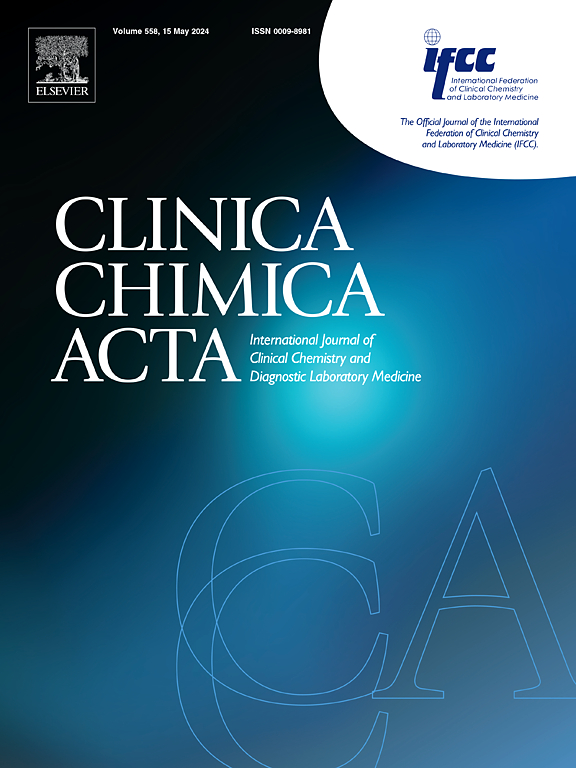六种血浆生物标记物对进行性核上性麻痹、多系统萎缩和帕金森病的诊断价值。
IF 3.2
3区 医学
Q2 MEDICAL LABORATORY TECHNOLOGY
引用次数: 0
摘要
研究目的本研究旨在评估六种血浆生物标志物对进行性核上性麻痹(PSP)、多系统萎缩(MSA)和帕金森病(PD)不同亚型的诊断能力:方法:采用单分子阵列(Simoa)技术对一组帕金森病(PSP)、多系统萎缩症(MSA)、不同亚型帕金森病(PD)患者和健康对照组(HCs)的神经丝蛋白轻链(NfL)、磷酸化tau-181、胶质纤维酸性蛋白(GFAP)、淀粉样β 42(Aβ42)和淀粉样β 40(Aβ40)水平进行了测定:结果:血浆NfL和GFAP水平有利于区分疾病组和健康对照组。血浆NfL、Aβ42和Aβ40可区分非典型帕金森综合征(APS)和帕金森病及其亚型。GFAP 可将 APS 与震颤为主的帕金森病区分开来,但不能将 APS 与姿势不稳和步态障碍为主的帕金森病区分开来。当结合使用多种血浆生物标志物时,鉴别效果会更好:结论:在这项研究中,血浆生物标志物NfL、GFAP、Aβ42和Aβ40在PD和APS中表现出较高的鉴别诊断价值,可作为临床潜在的诊断生物标志物。血浆生物标记物组合可提高PD和APS比较中的鉴别诊断效果。本文章由计算机程序翻译,如有差异,请以英文原文为准。
Diagnostic value of six plasma biomarkers in progressive supranuclear palsy, multiple system atrophy, and Parkinson’s disease
Objectives
This study aimed to evaluate the diagnostic ability of six plasma biomarkers in progressive supranuclear palsy (PSP), multiple system atrophy (MSA), and different subtypes of Parkinson’s disease (PD).
Methods
Neurofilament light chain (NfL), phosphorylated tau-181, glial fibrillary acidic protein (GFAP), amyloid-β 42 (Aβ42), and amyloid-β 40 (Aβ40) levels were measured using the single-molecule array (Simoa) technique in a cohort of patients with PSP, MSA, different subtypes of PD, and healthy controls (HCs).
Results
Plasma NfL and GFAP levels were beneficial in discriminating between the disease groups and HCs. Plasma NfL, Aβ42, and Aβ40 could distinguish atypical Parkinsonian syndrome (APS) from PD and its subtypes. GFAP could discriminate APS from tremor dominant PD but could not discriminate APS from postural instability and gait disorder dominant PD. The efficacy of differentiation improved when a combination of multiple plasma biomarkers was applied.
Conclusions
In this study, the plasma biomarkers NfL, GFAP, Aβ42, and Aβ40 exhibited high discriminatory diagnostic value in PD and APS, and could be used as clinically potential diagnostic biomarkers. Plasma biomarker combinations could improve the differential diagnostic efficacy in the comparisons of PD and APS.
求助全文
通过发布文献求助,成功后即可免费获取论文全文。
去求助
来源期刊

Clinica Chimica Acta
医学-医学实验技术
CiteScore
10.10
自引率
2.00%
发文量
1268
审稿时长
23 days
期刊介绍:
The Official Journal of the International Federation of Clinical Chemistry and Laboratory Medicine (IFCC)
Clinica Chimica Acta is a high-quality journal which publishes original Research Communications in the field of clinical chemistry and laboratory medicine, defined as the diagnostic application of chemistry, biochemistry, immunochemistry, biochemical aspects of hematology, toxicology, and molecular biology to the study of human disease in body fluids and cells.
The objective of the journal is to publish novel information leading to a better understanding of biological mechanisms of human diseases, their prevention, diagnosis, and patient management. Reports of an applied clinical character are also welcome. Papers concerned with normal metabolic processes or with constituents of normal cells or body fluids, such as reports of experimental or clinical studies in animals, are only considered when they are clearly and directly relevant to human disease. Evaluation of commercial products have a low priority for publication, unless they are novel or represent a technological breakthrough. Studies dealing with effects of drugs and natural products and studies dealing with the redox status in various diseases are not within the journal''s scope. Development and evaluation of novel analytical methodologies where applicable to diagnostic clinical chemistry and laboratory medicine, including point-of-care testing, and topics on laboratory management and informatics will also be considered. Studies focused on emerging diagnostic technologies and (big) data analysis procedures including digitalization, mobile Health, and artificial Intelligence applied to Laboratory Medicine are also of interest.
 求助内容:
求助内容: 应助结果提醒方式:
应助结果提醒方式:


